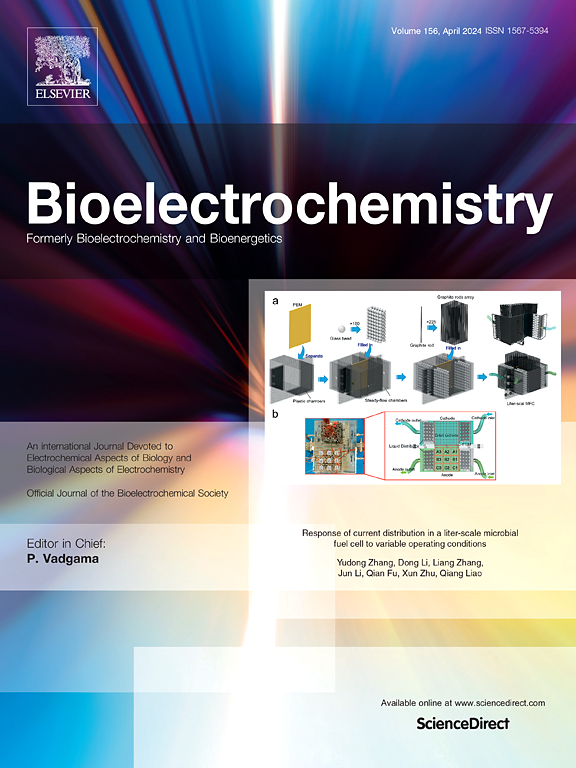基于氢键有机框架的电化学配体传感器检测痕量青霉素G
IF 4.5
2区 化学
Q1 BIOCHEMISTRY & MOLECULAR BIOLOGY
引用次数: 0
摘要
本研究通过氢键驱动有机单体自组装,合理设计和合成了两种氢键有机框架(HOFs)。hof具有丰富的结合位点和扩展的π共轭网络,可用于适配体的固定。与非多孔HOF-BPTCA相比,多孔HOF-TCBP可以协同提高电子导电性和可达功能区域,从而制造出高性能的电化学适体传感器。青霉素G (PG)是一种广泛使用的广谱抗生素,选择它来研究适体传感器的传感能力。基于HOF-TCBP的电化学感应传感器可以用差分脉冲伏安法(DPV)定量检测痕量PG,其线性范围为0.0005 ng mL - 1 ~ 0.5 ng mL - 1,检测限低(1.04 fg mL - 1)。本研究为构建高性能的基于hof的电化学感应传感器开辟了新的思路,并扩展了其在电生物传感领域的应用。本文章由计算机程序翻译,如有差异,请以英文原文为准。

Electrochemical aptasensors based on hydrogen-bonded organic frameworks for detecting trace penicillin G
This study presents the rational design and synthesis of two hydrogen-bonded organic frameworks (HOFs) via hydrogen-bonding-driven self-assembly of organic monomers. HOFs have abundant binding sites and extended π-conjugated networks for aptamer immobilization. Compared to non-porous HOF-BPTCA, the porous HOF-TCBP can synergistically enhance both electronic conductivity and accessible functional area to fabricate a high-performance electrochemical aptasensor. Penicillin G (PG) is a widely used broad-spectrum antibiotic, which is selected to investigate the sensing ability of aptasensors. The electrochemical aptasensor based on HOF-TCBP can quantitatively detect trace PG using differential pulse voltammetry (DPV), which exhibits a good linear range from 0.0005 ng mL−1 to 0.5 ng mL−1 and a low limit of detection (1.04 fg mL−1). This work opens a novel idea for constructing high-performance HOFs-based electrochemical aptasensors and expands their applications in the electrical biosensing field.
求助全文
通过发布文献求助,成功后即可免费获取论文全文。
去求助
来源期刊

Bioelectrochemistry
生物-电化学
CiteScore
9.10
自引率
6.00%
发文量
238
审稿时长
38 days
期刊介绍:
An International Journal Devoted to Electrochemical Aspects of Biology and Biological Aspects of Electrochemistry
Bioelectrochemistry is an international journal devoted to electrochemical principles in biology and biological aspects of electrochemistry. It publishes experimental and theoretical papers dealing with the electrochemical aspects of:
• Electrified interfaces (electric double layers, adsorption, electron transfer, protein electrochemistry, basic principles of biosensors, biosensor interfaces and bio-nanosensor design and construction.
• Electric and magnetic field effects (field-dependent processes, field interactions with molecules, intramolecular field effects, sensory systems for electric and magnetic fields, molecular and cellular mechanisms)
• Bioenergetics and signal transduction (energy conversion, photosynthetic and visual membranes)
• Biomembranes and model membranes (thermodynamics and mechanics, membrane transport, electroporation, fusion and insertion)
• Electrochemical applications in medicine and biotechnology (drug delivery and gene transfer to cells and tissues, iontophoresis, skin electroporation, injury and repair).
• Organization and use of arrays in-vitro and in-vivo, including as part of feedback control.
• Electrochemical interrogation of biofilms as generated by microorganisms and tissue reaction associated with medical implants.
 求助内容:
求助内容: 应助结果提醒方式:
应助结果提醒方式:


